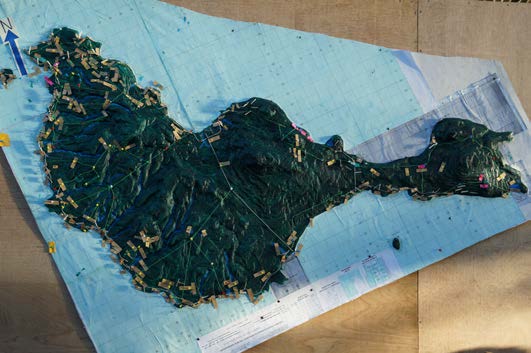Improving natural resource management, mapping community rights and bolstering climate change adaptation – participatory 3D modelling can help to do all this and more. Developed in the early 1990s in Southeast Asia, the technique offers communities a tangible way of visualising tacit knowledge, producing stand-alone relief models that depict natural surroundings, but also cultural information, helping groups to assert their rights and protect their traditional knowledge from outside exploitation.
 CTA has been in the forefront of P3DM development in African, Caribbean and Pacific countries, launching it in Fiji, Gabon, Kenya and Trinidad and Tobago, and helping to foster South-South cooperation to spread the practice further afield. The Power of Maps: Bringing the Third Dimension to the Negotiation Table documents some of the achievements obtained so far. All twelve of the case studies presented show how the process of building 3D maps has led to positive changes.
CTA has been in the forefront of P3DM development in African, Caribbean and Pacific countries, launching it in Fiji, Gabon, Kenya and Trinidad and Tobago, and helping to foster South-South cooperation to spread the practice further afield. The Power of Maps: Bringing the Third Dimension to the Negotiation Table documents some of the achievements obtained so far. All twelve of the case studies presented show how the process of building 3D maps has led to positive changes.“Traditional knowledge is gaining recognition at the international level, but at the local level, government officials and technocrats tend to dismiss it as anecdotal and scientifically unproven,” said CTA P3DM expert and Senior Programme Coordinator ICT Giacomo Rambaldi. “The process documented in this book enables knowledge holders to visualise and georeference their traditional knowledge and to engage outsiders in a peer-to-peer dialogue.”
Building a P3DM model generally involves the entire community, with the elders supplying their traditional knowledge and children taking charge of the actual construction, using cardboard, paints, pushpins and yarn. An important part of the exercise is the way it brings generations together, giving value to the contributions of each and making people feel a sense of pride – in their surroundings and heritage and in the map itself.
On the Pacific island of Ovalau, a P3DM initiative led farmers and fishers to adopt more sustainable land use and fisheries practices, with significant increases in production as a result. Impacts included a doubling of fish stocks, a sizeable increase in crop output and a rise in the number of tourists visiting the island. In Madagascar, the creation of a 3D map drew an initially sceptical community into a watershed planning process, with people quickly seeing the benefits in terms of improved resource management and income generation.
Members of a pygmy community displaced to make way for a protected area in the Democratic Republic of Congo used the web of knowledge displayed on their 3D map to regain access to traditional lands and claim a role in managing them. Meanwhile, in Kenya, a three-dimensional mapping exercise helped the Ogiek tribe to document its ancestral land rights and knowledge systems, with far-reaching repercussions – including shaping government policy on indigenous peoples.
Climate change poses a special threat to vulnerable small island states, and on the Caribbean island of Tobago, P3DM has been used to guide community driven disaster risk reduction strategies. In another three-dimensional mapping exercise in the region, the experience of building a climate risk map of Grenada has produced the added spin-off of strengthening the capacity and professional networks of local organisations. One unexpected outcome has been the signing of an international partnership to fund the replanting of mangroves, as part of an ecosystem management strategy to protect the island from persistent hurricanes that are endangering lives and livelihoods.
Further information:
Watch The enabling power of participatory 3D mapping among the Saramaccan Peoples of Suriname (part 1 & 2):Visit CTA’s PGIS website
Read about the life-changing effect of P3DM
Known locations of P3DM exercises in Africa, the Caribbean and the Pacific
Collection of case studies: www.iapad.org
P3DM on social media:
www.facebook.com/ppgiswww.twitter.com/ppgis
www.vimeo.com/channels/pgis
www.ppgis.net



